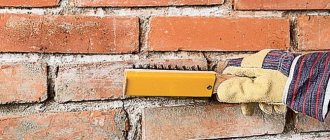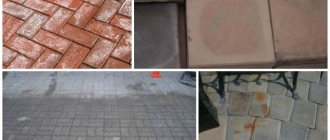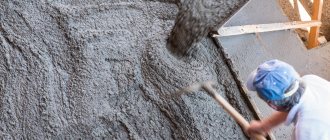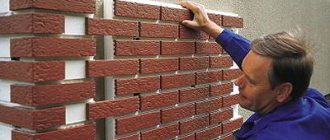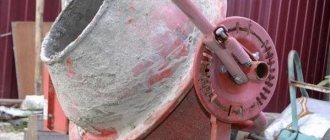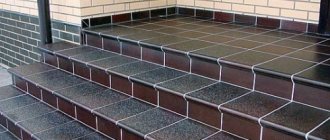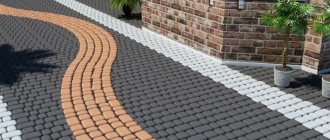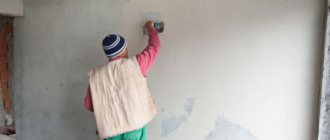Often, after repairs, traces of the building materials used during the work remain on the tiles. This can be a cement composition or adhesive on ceramic or porcelain tiles. No matter how carefully the master works, the problem arises often and it is very difficult to clean the old mortar from the tiles, but it is possible. The work is done in several ways.
Traces of mortar on the tiles
Methods for cleaning tiles using improvised means
If the solution has hardened, it will not be possible to wipe it off with a rag. It is recommended to pay attention to abrasive tools.
Step-by-step instructions for performing the work:
- It is recommended to soften the solution. Traces of the composition on the tiles are soaked with clean running water. When it comes to polymer glue, experts advise using light acidic agents or solvents. Using a spray bottle, apply vinegar, lemon juice, and glass cleaner to the contaminated area. Any of the options found in the house will do.
Softening
- We proceed to the mechanical option of removing dirt from the tiles. After soaking and absorbing moisture, the solution, or rather its upper ball, becomes loose and plastic, susceptible to mechanical removal. They try to remove the solution using penza, sandpaper, a brush with metal bristles or a construction float. But it is recommended to do this carefully so as not to damage (scratch) the tile.
Mechanical cleaning
Important! A small spot on the tile is removed with a nail file. But it won’t be possible to process a large area of tile this way. The glue is difficult to wipe off.
- The traces of mortar (tile adhesive) on the tiles are softened for the second time. This is done when the decrepit layer of pollution has already been removed. After softening, work on mechanical cleaning of the tiled surface begins again. The manipulations are repeated until the tile is completely clean. May need 3-5 times. It all depends on the thickness of the solution layer and how long it has been hardening.
- The final stage of tile cleaning ensures that adhesive stains are easily and accurately washed away. A good tip is to use a household brush or sponge to clean ceramic dishes. The best option is a melamine sponge, which prevents the use of cleaning chemicals - solvents.
If it visually appears that there is only a drop of glue on the tile, you should not try to pick it up and remove it. Adhesion of materials is at a high level. There is a high chance of chipping off part of the ceramic coating at the dacha along with the adhesive solution.
How to clean tiles from cement, white deposits, grease
To wash paving stones from grease, cement or white deposits, it is necessary to use devices and compositions to effectively clean a specific type of contamination. If means of combating some compounds are used against other substances, this may at least be ineffective, and in the worst case, it will only aggravate the situation.
To destroy dirt, mechanical and chemical cleaning methods are used.
Hand tools help remove excess from paving slabs:
- scraper;
- boaster;
- hammer;
- sandpaper;
- brush with steel wire bristles;
- chisel;
- sand;
- bit.
Special cleaning products
It is not always possible to remove dried old cement from a tiled surface using improvised materials. It is recommended to arm yourself with specialized construction chemicals. In construction markets, along with adhesive solutions, they sell means for removing them - solvents. An active chemical reaction allows the adhesive to be removed from the surface of the tile.
Specialized cleaning products
Distinctive features of construction plan solvents:
- the solvent is selected depending on the type of glue used. The composition of the solution is first specified on the packaging of the solution;
- The degree of activity of the remover differs among different manufacturers. Light, non-aggressive compounds promote softening. More aggressive solvents allow you to completely dissolve the cement mortar and glue. The tiles can be cleaned as easily as possible, without any effort or complex mechanical cleaning;
- aggressive types of remover can damage the top layer of tiles, especially glazed ones. It is recommended to first apply the composition to an inconspicuous area of the tile. Pieces of tiles that remain after repairs will do;
- solvent is a dangerous substance. It is recommended to use personal protective equipment for your hands – rubber gloves. While working with the wash, ventilation is turned on. If an aggressive compound gets on the skin or mucous membrane, you must immediately rinse the area with a large volume of water;
- It’s good when the tile covering is cleared of mortar before grouting the joints. The solvent will soften the glue as quickly as the grout. The seams are sealed with construction tape.
When working with solvent, experts advise strictly following the manufacturer’s recommendations. It is prohibited to deviate from the recommended sequence of work. Failure to follow the rules for working with a remover can lead to damage to the tiles and deterioration in the aesthetics of its appearance.
Types of removing cement-sand composition from tiles
Based on the type of funds used, they are divided into:
- chemical;
- mechanical;
- combined option for removing glue.
Classification is carried out according to the intensity of exposure. But a clear division is not expected; the result is important.
Fresh cement composition
The best cleaning results are achieved if dirt is removed from the tiles immediately. After completing a certain stage of construction work, you need to immediately clean the surface. You can simply rinse the area with water. Although minimal traces of glue and cement will remain after poor-quality washing, they will not be able to achieve maximum hardness. They can be removed again without much difficulty.
Fresh cement mortar
Fresh cement composition is removed with a regular rag soaked in water. You should be careful with a glossy finish. Small grains of cement sand can act as an abrasive and scratch the tile. There is no need to press the fabric against the surface too much. Movements are performed light and neat.
Traces of cement no older than a month
The standard period for complete hardening and strengthening of glue or cement is 28 days. It is recommended to remove the contamination before this time. UNTIL final adhesion of materials has occurred.
It is better to start by washing off the cement mortar with water. Additionally, a nylon brush is used. The directed force is performed not towards the gloss, but along it.
Initially, traces of glue are softened with a soap solution. A break is taken for 20 minutes. Afterwards the glue is removed with regular softening with plain water.
Important! If water simply cannot remove cement marks on the tiles, you should use household cleaners.
Old cement stains
What makes them more complex are traces of glue (cement), which “live” on the surface of ceramic tiles for months and even years. In this case, the building composition not only gained maximum strength and hardness. Sometimes it penetrates into the structure of the ceramic surface. After removing such stains, pigment marks often remain on the coating. You can't get rid of them anymore. The ideal appearance cannot be achieved.
Old cement marks
Builders recommend pre-preparing the contaminated area. Drops of cement are softened with a solution of hydrochloric acid. The substance is applied only to stains. Glue is not resistant to chemical attack, while ceramics show better results in this matter. It is better to initially experiment with applying acid to an inconspicuous area of the tile. Tiles are not omnipotent. It might go bad. After 5 hours the tiles are checked. If there are no pigment spots and the surface is not corroded, you can begin applying acid. After some time, the contaminated ceramic area is washed with water. Acid is applied again. A technical break is taken for 12 hours. The substance takes time to completely destroy the structure of old, dried cement.
The next step is to wash off the glue with water. Mechanical cleaning of the solution with a brush may be required.
You can use not only solutions, but also strong concentrated cleaning agents that contain acid. Information must be indicated by the manufacturer on the packaging.
Cleaning Features:
- As a universal option, not only soap, but also saline solution is used. Regular table salt is used as a softener. The area is covered with salt and abundantly moistened with water until a paste-like mass is obtained. A technical break is taken for a while so that the salt composition destroys the structure of the cement;
- There is a wide range of specialized solvents designed to remove cement and adhesive stains. Their cost is low. If possible, it is recommended to give preference to such specialized substances. They contain all the necessary components that facilitate a quick and gentle option for getting rid of old cement marks on the tiles;
- Removal of cement mass using a standard construction spatula is effective. It is important to use only a new tool. There should be no remains of old building materials or bending. Any ceramic surface can be cleaned. But the glossy finish requires special care. Increases the risk of scratches;
- large old concrete sagging can be removed exclusively with a chisel and hammer. It is allowed to use a grinder with specialized brush attachments. Builders recommend working exclusively at low power. This option for removing cement is only suitable in cases where there is no need to preserve the ceramic coating or it is completely unimportant. The main task is to clean production areas and prepare them for subsequent repairs.
How to clean paving slabs to a shine
In order for your pavement to shine like new, it needs to be maintained regularly. About once a month, it depends on how often and in what quantity people walk on it, you need to do the following:
- Use a broom or soft-bristled brush to remove all dust and residue from the path. Repeat the procedure 2-3 times, paying special attention to gaps and notches.
- Dilute any dishwashing detergent in a bucket of hot water to create foam. Moisten a rag or brush with the solution. Clean fresh stains first. After this, rinse the entire surface of the coating.
- Treat the path with a water repellent, for example, Neogard, Tiprom M, GKZh-11.
Thanks to the systematicity of these actions, the pavement will retain its brightness and shine, and any liquids from its surface will be repelled rather than absorbed.
The quality of the tiles is lost if the path is sprinkled with salt in winter.
Safety precautions when working with solvents and acidic substances
When working with aggressive chemical compounds, it is important to strictly adhere to minimum safety precautions. Personal and collective protective equipment is used:
- for hands – rubber gloves (mittens);
- for the visual organs - safety glasses with transparent lenses;
- for the respiratory system - a respirator and ventilation system;
- for the skin - a protective robe or suit.
If, while working with solvents, they come into contact with the skin, you should immediately rinse the damaged area of the body with water. Specialized cleaning liquids, although they smell nice, have a negative effect on the skin and respiratory tract. It is necessary to carry out manipulations to clean ceramics only with the ventilation system turned on or windows open (natural ventilation). After applying the acid to the stain, leave the room. Take extra time to avoid inhaling toxic fumes.
If necessary, you can save yourself the hassle of cleaning the tiles and contact a cleaning service. Our specialists will give your ceramic coating the perfect appearance as quickly and professionally as possible. Sometimes it is cheaper to turn to professionals than to conduct experiments yourself, spending money on cleaning materials and liquids. Especially when it comes to high-quality, expensive ceramic tiles that you don’t want to ruin.
